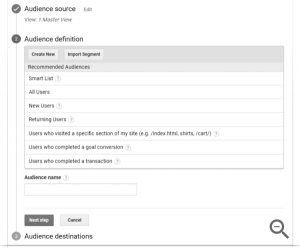With things like big data and GoToMeeting, large groups of people can collaborate over great distances, using this data to make a series of decisions about their new website.
And then once they’ve implemented these decisions, a new group of folks comes in to question everything – usually a board of directors or someone from the C-Level.
Sound familiar? It’s never pretty.
I’m not anti-big data. And I am not naïve enough to think that one person can make all the decisions regarding a website. But, the scenario depicted above often ends in failure.
Your website has an audience, and it isn’t you! Personal opinions on design and structure can certainly be valid. But, everything should be run through the audience filter – Is it what they want? What they need?

We’ve been managing website projects for 15+ years. We’ve seen groupthink obliterate a perfectly good website time and time again. It’s easy to over-design a website if you’re not focused on what matters.
To avoid groupthink while still allowing all stakeholders to have a voice, you need an agreed upon process right from the start. At a bare minimum, I recommend the following:
Let Them Be Heard Early On
Give stakeholders a chance to contribute. Using a survey, interviews, or simply a list of questions in a Word doc, gather their input. Don’t simply ask them to “tell us what you think the new website needs.” Because, they will. 🙂
Instead, walk them through the survey with questions that reinforce that this website is for your audience, not your stakeholders…
- What are the top things your audience needs from your website?
- What, if anything, on your current website is working well for your audience? What is not? Is there data to support either?
- What is missing that your audience needs (based on what they’ve told you)?
- How do you measure success based on your audience needs?
- How do you deal with failure? In other words, if something isn’t working for your audience, how would you address and correct this?
- Who will manage content, both for the build and ongoing?
These are just some sample questions. Your list will likely be more specific to your organization. But, it needs to always be focused on the target audience.
Once you have all of the survey results, place them in a spreadsheet or some other way that allows you to compare each answer against another.
The goal of this is twofold:
- Consolidate all similar answers into one clear, concise statement.
- Eliminate any responses that do not support your goals of developing a website focused on your target audience.
By gathering everything in one place, you know where everyone’s expectations are. Then discuss those expectations to reach common ground.
You’ll use this information as a guide for designing and developing this website. So, make sure you have buy-in on the way forward.
Develop A Scope Of Work
This is a step that many organizations will skip. They’re excited to get started and jump right into design. Wait, calm down, you’re not ready.

Think of your website as a large dinner party. You need to plan the menu, clean the house, and maybe pick out some good music.
Your scope of work document is your party plan. Without the party plan, you’re just winging it. That may have worked in college, but you’re better than that now!
Taking into account the information provided in the previous step, you’ll want to assemble the following:
- Details about your target audience (buyer personas if you have them).
- Details about the information, products, functionality that your audience wants.
- A sitemap – simply an outline that lists the parent and children pages.
- A color palette (based on your branding guide if you have one).
- Sample images (you can use stock photos here to suggest photos you plan to shoot).
- A wireframe – a simple outline of the homepage and possibly the subpages depending on the complexity of your website.
- Definitions of success and the paths to get there.
- Analytics data, if available, to support your plan (past performance data regarding content and functionality strategies).
Once this document is assembled you have a choice to make. Does this go out to all stakeholders for feedback or only a select few? Depending on your organization, you’ll need to decide who is involved.
The main criterion for this decision is “how will leaving someone out affect the outcome of this project?”
This is where things can get sticky. If you choose to leave people out of this step, be certain that they are not expecting to come back in at some point and make decisions about design or development plans.
To put it another way, are you hiding this from them in the hopes that you can sneak things by them. Hey, it happens. And, based on my experience, it’s always a bad idea…
“Hi, web designer…um, well, Bob just saw the website and even though it’s approved and ready for launch, we have a long list of changes we need made.”
And please don’t misunderstand me. I’m not hating on Bob. Bob has a role to play. But there is a time and place for that, and it isn’t at the very end of the project when she stumbles upon the website you’ve been working so hard to finish.
It all comes down to planning, communication, and setting clear expectations. And all of this is done while asking the question “is this what our audience wants?”
And remember, no spin because Spin Sucks (See what I did there? Read the book, it’s awesome). Just focus on what Jay Baer calls Youtility (read the book, it’s awesome).
(173)







